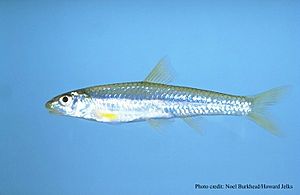Longnose shiner facts for kids
Quick facts for kids Longnose shiner |
|
|---|---|
 |
|
| Conservation status | |
| Scientific classification | |
| Synonyms | |
|
The longnose shiner (Notropis longirostris) is a type of ray-finned fish. It belongs to a group of fish called Notropis. These fish are known for their long snouts.
Contents
What Does the Longnose Shiner Look Like?
Longnose shiners are thin, straw-colored fish. They have a long, rounded snout and a wide, rounded head. Their mouth is large and almost flat.
Their eyes are small and set high on their head. This makes them look like they are always looking up. Their teeth are hooked and good for grinding food.
The fins on their back (dorsal) and belly (anal) are fairly tall. They have rounded tips. The dorsal fin usually has 8 rays. The anal fin usually has 7 rays.
These fish do not have scales on their chest. Their belly has some scales. A line along their side, called the lateral line, is complete and mostly straight.
Longnose shiners are usually no longer than 58 millimeters (about 2.3 inches). Adult males are about 34.9 mm long. Females are slightly smaller, around 33.8 mm long.
Their back and sides are pale yellow. They have a faint, dark pattern and a thin stripe down their back. Their lower sides and belly are shiny silver or white.
Sometimes, they have a faint stripe along their side, especially near their tail. Their fins do not have dark colors. When they are ready to breed, especially males, their fins turn a bright lemon yellow. Males might also have yellow snouts.
What Do Longnose Shiners Eat?
Longnose shiners usually eat during the day. They are most active in the morning. They mainly eat fly larvae and other insects that live in the water.
They also eat tiny crustaceans like copepods and cladocerans. Ants are the only land insects they eat.
Longnose shiners also eat different plant materials. This includes seeds from plants like sedges, tiny diatoms, and algae. As they grow bigger, their diet becomes more varied. Older longnose shiners might also eat mayfly larvae.
Where Do Longnose Shiners Live?
Longnose shiners live in groups near the bottom of streams. They prefer places with a gentle current. They like clean sand or small gravel at the bottom of medium to large streams.
Their homes are often shallow, about 60 centimeters (2 feet) deep. They like clean, sandy areas along the edges of sand bars. They are most common where the current is slower.
You can also find them where stream banks have woody plants or bushes. They have even been found in areas changed by construction, like around bridge repair sites.
Reproduction and Life Cycle
Male and female longnose shiners are found in equal numbers. Both sexes become adults when they are about 30 mm long. Males average 34.9 mm long, and females average 33.8 mm long.
Larger females usually lay larger eggs. These eggs are about 0.84 to 0.95 mm wide. The size of females and their eggs can depend on how much rain runs off into their habitat.
The breeding season for longnose shiners lasts from March to October. This happens when the water temperature is between 17 and 29 degrees Celsius (63-84°F). Females usually lay eggs multiple times during one breeding season.
There might be two busy breeding times. One is at the very start of the season. The other is in the middle, around July. Females usually lay between 62 and 121 mature eggs in one batch. They can lay anywhere from 15 to 129 eggs in total.
Longnose shiners do not build nests or prepare the ground for their eggs. Instead, they scatter their eggs and sperm into the water. This means the parents do not take care of the eggs or the young fish.
In the wild, longnose shiners usually live for 1 to 2.5 years. Some might live into their third summer, but most do not survive their third winter.
Where Are Longnose Shiners Found?
Longnose shiners live across the southeastern coastal states of the United States. Their range goes from Louisiana, west of the Mississippi River, all the way to Florida.
In Louisiana, they are common in the Florida parishes. They are also found north into the lower Ouachita River system. In Mississippi, they live in the lower Yazoo River system.
You can also find them in Georgia, in the upper Altamaha River system and the Ocmulgee River system. Some smaller groups live in the upper Coosa River system and other small streams in Alabama.
Why Are Longnose Shiners Important to Humans?
Longnose shiners are too small to be caught for food or sport. However, people often use them as bait when fishing. Their shiny silver color helps attract bigger fish.
What Do Their Names Mean?
The genus name, Notropis, was given by Rafinesque. It means "back keel" in Greek. This name came from how the fish looked when they were dried up.
The species name, longirostris, comes from Latin words. Longus means "long," and rostrum means "snout." This name describes the long snout of this fish.
See also
 In Spanish: Notropis longirostris para niños
In Spanish: Notropis longirostris para niños


